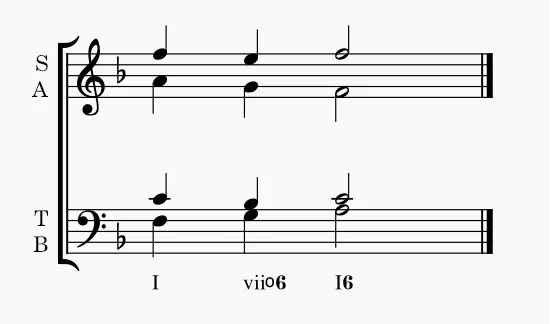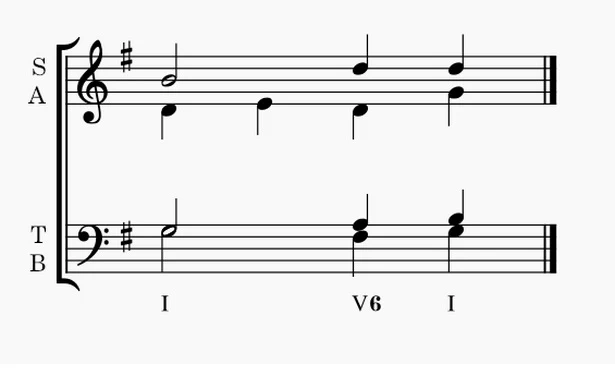Do you want to learn the intricacies of the First Inversion Triads?
The first inversion triads are formed by moving the lowest note of any triad an octave higher. They help you to have a melodic bassline, variety in your music, imperfect cadences, use diminished chords, etc.
In this article, we will elaborate on their utilities, part writing rules, voice leading, their use as passing chords, neighboring chords, and non-chord tones.
Read the complete article to know all this and more.!
Why use First Inversion Chords
The important question is why you need the chord inversions in the first place. You can see some good reasons below:
- To have the melodic qualities in the bass line with the power to shape its contour. In the root position chords, the bass voice carrying is constrained to motion by leaps only defined by the root note of the chords. The Soprano and the Bass, the two outer voices, are the two most important voices for melody. Having only the root position triads in your chord progression restricts the variations in your music, as Bass does not have any melodic movement.
- This will allow you to have a variety of bass notes.
- As you may know, the perfect authentic cadence (PAC) requires both the V chord and the tonic to be in their root position. Hence, in scenarios where you do not need a PAC, you may reduce the weight or impact of the V – I progression by using the V chords in the first inversion.
- Diminished chords are not used in their root positions as the Bass is a prominent voice along with the Soprano & we don’t want a tritone interval with the bass note. In its first inversion, the intervals of the other notes from the bass note are a minor 3rd and a major 6th. There is still a tritone interval between the original root and the 5th [3 1 5], but now it is in inner voices and not as prominent. It still has enough tension but does not sound as harsh. Remember only to play the diminished triads in their first inversions.
- Any major or minor triad intervals after their first chord inversion are a 3rd and a 6th from the bass note. Hence, in the figured bass notation, they are designated as I6 or V6 chords. Moving these sixth chords in parallel sounds really good.
Part Writing Rules for the First Inversion Triad
The rules for four-part writing the inverted triads in their 1st inversion are:
- Doubling: For any minor or major triad, try to double the Soprano with the additional doubled note going in an inner voice, if feasible. This will reinforce the Soprano.
- The first point is a recommendation only. Actually, you can double any note except the leading tone belonging to the scale degree 7. The doubling of the original root and the 5th is preferred, subject to an easy and smooth approach and exit.
- In a diminished 1st inversion triad, double the 3rd. This is because the 1st and 5th are part of the tritone.
In three-part writing, we always write the complete chord without omitting any note of the triad. Remember that in the root inversions, we had the option of doubling the root and omitting the 5th.
Representing the First Inversion Chord
The 1st inversion chords are either written in the form of slash chords or through a figured bass notation. In slash chord notations, they are shown as C/E, which means the C chord with E as the bass note. In the 1st inversion, the original C major chord with notes [C E G] is inverted as [E G C].
In figured bass notation in the C scale, the C chord in the 1st inversion is I6. The second inversion is [G C E] and is denoted as I6/4.
Voice Leading Examples for the 1st Chord Inversions
You can now look at how the first inversion triads are used in Western music, along with the voice-leading details in each case.
Passing Chord
The diatonic passing chords are usually inserted between the other two diatonic chords in a progression to create more movement. These two existing chords have an interval of a major or minor third. Let us consider the example of the tonic chord in F major, I [F A C], and its first inversion triad, I6 {A C F}.
The vii06 triad [G Bb E], the vii0 triad in its first inversion, is used as the passing chord. Notice that I and I6 have the scale degree 1 and 3 notes as their bass, while vii06 has the scale degree 2 note as its bass, just in between I and I6, so this will lead to a stepwise rise in the bass note as shown in the diagram below.

Notice that we had doubled the third G in the vii06 chord.
Neighboring Chords.
This is an extension of the concept of the neighboring tone to chords, where you use the diatonic chords in such as way that there is a step movement in the bass note from Chord A to B in one direction and a step movement back from Chord B to A.
If you see our diagram for I – V6 – I for neighboring NCT carefully, you will note the step movement in the bass tone from G to F to G without even using the NCT.

Voice Exchange
Look carefully at the voice leading in our example of the passing chord above (I – vii06 – I6). Note that as the bass is moving up in step, the alto is moving down in step. This downward step movement can happen in the other two voices – Soprano and Tenor instead of the Alto. This is basically the voice exchange happening between the chords.
The bass moves from F to G to A, while the Alto moves from A to G to F in the reverse direction.
Passing and Other Non-chord Tones (NCT)
As you would have guessed, a non-chord tone (NCT) is a pitch that does not belong to the chord playing at that time. It is an embellishment tone that modifies the melodic profile and the music texture. It is more commonly found on a weak beat. Each NCT type has to be prepared and resolved in a particular way.
We have dealt with the passing and other non-chord tones in detail in our article on the subject. These non-chord tones can be used with the first inversion of the triads.
First Inversion in A Seventh Chord.
Any 7th chord has 4 notes. Hence it can have three inversions. This article is on the first inversion of chords. We will deal with the second inversion and the third inversion in separate articles. Also, we have a separate article on the inversions of the 7th chord.
Conclusion
We hope that you did find the information in the article helpful. You are requested to leave comments in the section below if you need further clarification. We will respond to the queries in a reasonable time.
